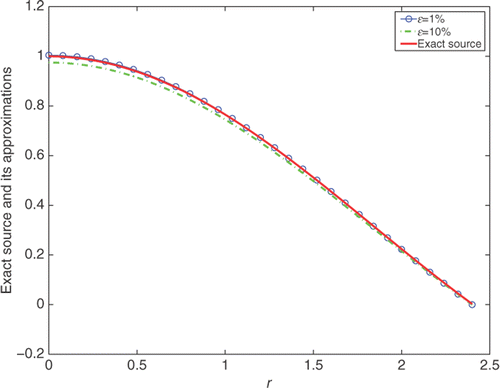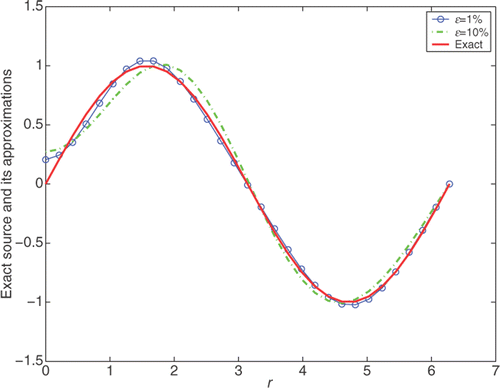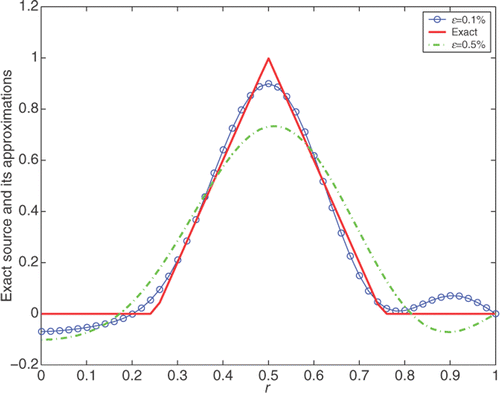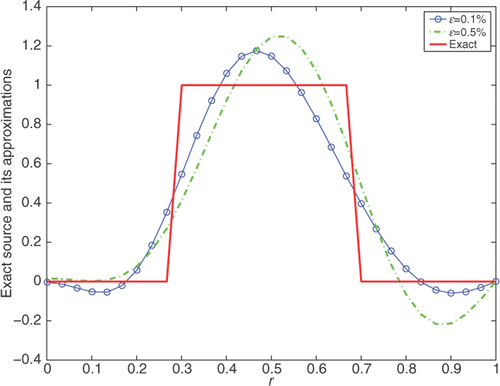Abstract
In this article, we consider an inverse problem of determining an unknown heat source term from the final temperature history of the radial domain. This problem is ill-posed: the solution (if it exists) does not depend continuously on the final data. A spectral method is applied to formulate a regularized solution and a logarithmic-type error estimate for the regularized solution is given under a suitable choice of regularization parameter. Numerical results are presented to illustrate the accuracy and efficiency of the method. Meanwhile, the uniqueness of solution for the problem is provided.
1. Introduction
Let Ω ∈ ℝN be a heat conduction body, T > 0 and u represent the temperature satisfying the following heat equation:
(1)
where a2 is the thermal diffusivity and the right-hand side f denotes a heat source. Unfortunately, the characteristics of source in actual problems are sometimes unknown. There are inverse problems which determine the heat source from the final temperature history or the boundary temperature history.
The inverse heat source problems have extensive application background and important theoretic significance, so the problems have a long development history Citation1–9. These problems are classical ill-posed problems, and some theories and extremely effective algorithms have been obtained. For instance, uniqueness and conditional stability results can be found in Citation10.
In recent years, due to taking a more and more important role in migration of groundwater, identification and control of pollution source and environmental protection, inverse heat source problems have been considered by many authors by different methods Citation11–21. Namely, these have been the mollification method Citation17,Citation18, iterative regularization methods Citation19–21, boundary element method Citation13, the finite difference method Citation14 and radial basis functions Citation12. However, the results available in the literature on the inverse heat source problem are mainly devoted to numerical methods. Only a few analytical methods were presented for these problems Citation22,Citation23. But in most cases the stability theory with explicit error estimate has not been generalized accordingly. In this article, we use a spectral method to deal with an inverse heat source problem in a radially symmetric region and obtain a logarithmic-type error estimate for the regularized solution.
The physical model considered here is an infinitely long cylinder of radius r0 with given initial temperature, which is considered axisymmetric and the surface temperature distribution is zero. The correspondingly mathematical model of our problem can be described by the following radial heat equation:
(2)
with the initial condition and final observation at t = T, namely
(3)
and the boundary conditions
(4)
where r is the radius. For simplicity, in this article we assume that the initial temperature vanishes. If the initial condition u(r, 0) = h(r) does not vanish, the problem can be divided into a well-posed problem and an ill-posed problem with u(r, 0) = 0.
The inverse heat source problem (1.2–1.4) requires the recovery of pair of functions (u, f). This problem is an ill-posed problem (the details will be given in section 2). Hence, regularization is needed. Prior to this study, Berntsson Citation24 and Tautenhahn Citation25 have applied a spectral method to the sideways inverse heat conduction problem. In this article, we will use their spectral method to solve the inverse source problem (1.2–1.4).
This article is organized as follows. In Section 2, the solution of the problem (1.2–1.4) is given. In Section 3, the uniqueness of the solution is provided. Section 4 presents the error estimate for the spectral method. To verify the efficiency and accuracy of the spectral method for problem (1.2–1.4), we give some numerical examples in Section 5.
2. Solution of problem (1.2–1.4)
As a solution of problem (1.2–1.4), we understand a function u(r, t) satisfying (1.2–1.4) in the classical sense and for every fixed r ∈ [0, r0], the function u(r, ·) ∈ L2[0, T] . In this class of functions, if the solution of problem (1.2–1.4) exists, then it must be unique (the details will be given in Section 3). We denote by L2[0, r0; r] the Hilbert space of Lebesgue measurable functions f with weight r on [0, r0]. We denote by (·, ·) and ‖·‖ the inner product and norm on L2[0, r0; r], respectively, with the norm
Assume that u(r, t) is the unique solution of problem (1.2–1.4). Applying the method of separation of variables, we have the following lemma.
Lemma 2.1
If the solution of problem (1.2–1.4) exists, then it is given by
(5)
where
(6)
J0(z) and J1(z) denote the 0th order and 1st order Bessel functions, respectively Citation26, and
are the sequence of roots of the equation J0(z) = 0 which satisfy
Proof
Applying the method of separation of variables, we seek a solution of problem (1.2–1.4) with the form
(7)
Substituting (2.3) into Equation (1.2) and boundary conditions (1.4), we can show that R(r) satisfies the following ordinary differential equation and boundary conditions:
(8)
(9)
where λ is an unknown constant. The eigenvalues of problem (2.4)–(2.5) are
and the corresponding eigenfunctions are
Thus the solution u(r, t) and nonhomogeneous term f (r) of problem (1.2–1.4) can be represented as follows:
(10)
(11)
where
According to the properties of J0(x), the eigenfunction's system
is complete, and orthogonal with weight r on [0, r0].
Substituting (2.6) and (2.7) into Equation (1.2) and the initial condition in (1.3), we can show that υn(t) satisfies
Solving this initial problem yields
(12)
Then, from (2.6) and (2.8) we have
From (1.3) at t = T we have
(13)
From the above formula we can obtain (2.2). This proves the lemma.▪
Since
formula (2.9) can be rewritten as
(14)
Denote by
(15)
the eigenfunctions system which is orthonormal with weight r on [0, r0]. It is also a complete system in L2[0, r0; r]. Using (2.2), (2.7) and (2.11), Equation (2.10) can be rewritten as
Then we have
and
(16)
Since measurement errors exist in g(r), the solution has to be reconstructed from noisy data gδ(r) which is assumed to satisfy
(17)
where g(·) and gδ(·) belong to L2[0, r0; r].
We also assume that there exists an a priori condition for problem (1.2–1.4):
(18)
where ‖ f ‖p is defined by
Applying (2.12) yields
(19)
Note that μn tends to infinity as n tends to infinity. Therefore
tends to infinity as n tends to infinity. Formula (2.15) implies a rapid decay of |(g(r), ωn(r))| for n large enough. But such a decay is not likely to occur in the measured noisy data gδ(r) at t = T. So, small perturbations of g(r) can blow up and completely destroy the solution f (r), i.e. problem (1.2–1.4) is ill-posed.
3. Uniqueness
Let g be a known function in L2[0, r0; r]. We consider the problem of identifying a pair (u, f).
Theorem 3.1
Let ui ∈ C2,1((0, r0) × (0, T] ), fi ∈ L2[0, r0; r], (i = 1, 2). If (ui, fi), (i = 1, 2) satisfy (1.2–1.4), then (u1, f1) = (u2, f2).
Proof
Put , then
satisfy
(20)
Introduce the function
(21)
where
(22)
From (3.1–3.3) we can show that ν(r, t) satisfies the following problem:
(23)
(24)
(25)
Using (3.4)–(3.6), we conclude that
Therefore,
i.e.
and thus ν(r0, t) = C(t). Combining this with (3.5) yields
(26)
Combining (3.7) with (3.6), we have
(27)
and
(28)
By differentiating (3.9) with respect to r, one obtains
. Substituting (3.7) and (3.8) into (3.2) yields
. Thus the uniqueness is proved.▪
4. Regularization and error estimate
In this section we consider under conditions (2.13) and (2.14) how to stabilize the radial inverse heat source problem (1.2–1.4) in the interval r ∈ (0, r0) by a spectral method.
A natural way to stabilize the problem is to truncate the series (2.12). Therefore, we introduce a function q given by
(29)
This function is called a regularizing filter and this choice of q is called the spectral cutoff Citation27. Then, for any noisy data gδ which satisfies (2.13) we get a regularized approximate solution
:
(30)
We call it the spectral cutoff solution of problem (1.2–1.4) in the interval 0 < r < r0. We now give the following results.
Theorem 4.1
Let f (r), given by (2.12), be the exact heat source for r ∈ (0, r0) and , given by (4.2), be the regularized approximate heat source to f (r). Let the measured data at t = T, gδ(r), satisfy the condition (2.13) and the a priori condition (2.14) be valid. If we select the regularization parameter α as
(31)
then the following stability estimate holds:
(32)
Proof
From (2.12) and (4.2), we find that
According to the properties of the Bessel function J0(x), there exists a positive constant c such that, for all natural numbers n,
(33)
Due to
(34)
we have
From conditions (2.13), (2.14) and the choice of α given by (4.3), we find that
Note that
Thus estimate (4.4) is proved.▪
We can see that estimate (4.4) is a logarithmical stability estimate which is similar to the convergence estimate in Citation28–30 on the surface.
Remark 4.2
In general, the a priori bound E in (2.14) is not known exactly. In this case, for Theorem 4.1, with
we have
where E is only a bounded positive constant and it is not necessary to know it exactly.
5. Numerical experiments
In this section, we will describe the numerical implementation of the spectral method, and some numerical results are given to illustrate the effectiveness of the suggested regularization method. For simplicity, we take T = 1 in all the following examples. The number of points on the grid in the space-time domain are taken to be M = K = 31.
For clarity, capital letter represents the samples from function g(·). The noisy data is generated by the function randn given in Matlab, i.e.,
The function ‘randn(·)’ generates arrays of random numbers whose elements are normally distributed with mean 0 and variance 1. The noise level δ is computed according to
Furthermore, in order to present the performance of the spectral method, we will define the relative root mean square error (RRMSE) as
where
and
represent the discrete form of the exact and approximated source, respectively.
From (4.2) we know that
Combining (4.1) and Simpson's rule, the above approximation can be written as
where N is the positive integer which satisfies
and
, and
Now we consider the following four examples.
Example 1
The exact solution of problem (1.2–1.4) with g(r) = J0(r)(1 − e−1) is given by
With the help of Matlab, we get some values of the roots of equation J0(z) = 0, i.e. μ1 ≐ 2.4049, μ2 ≐ 5.5202, μ3 ≐ 8.6539, μ4 ≐ 11.7916, μ5 ≐ 14.9310, μ6 ≐ 18.0711, μ7 ≐ 21.2117, μ8 ≐ 24.3525, etc. According to Remark 4.2, we take the regularization parameter α = 18.9005 with p = 2 and ϵ = 1%. It is obvious that if , we should take N = 1 for Example 1 with ϵ = 1%. In , the relative errors between the exact source function and the numerical ones corresponding to various N are presented. We can see that the computed source function is best for N = 1 and the result is acceptable for N = 2, 3, 4, 5, i.e. the approximations are not very sensitive to variations of the parameters. From , we find that M has little influence on the results when it becomes large, so we take M = 31 in the numerical test for this example.
lists the influence of p on α with ε = 1% for Example 1. It can be seen that the regularization parameter α corresponding to different p all satisfy . According to the definition of regularization solution, we should take N = 1 for these cases. As p has little influence on the regularization parameter, we always take p = 2 for simplicity.
shows the comparison between the exact solution and its approximation with different noise level for Example 1. We can see that with up to 10% noise in the data, the numerical source function is still in good agreement with the exact one.
Sometimes it is difficult to find a pair of functions (u, f) which satisfy the problem (1.2–1.4) simultaneously. For this case, we take a f (r) ∈ L2[0, r0] and compute the solution of the direct
(35)
(36)
(37)
to obtain the final data g(r) = u(r, T). The above-mentioned well-posed problem will be discretized by the standard Crank–Nicholson difference scheme. Now we consider three examples for which there are no analytical solutions available.
Figure 1. The comparison between the exact source function and the numerical ones with N = 1 and p = 2 for various levels of noise in the data, for Example 1.

Table 1. Relative error RRMSE(f) with ϵ = 1%, M = 31 for Example 1.
Table 2. Relative error RRMSE(f) with ϵ = 1%, N = 1 for Example 1.
Table 3. The influence of different p on α with ϵ = 1% for Example 1.
Example 2
Consider a smooth heat source f (r) = sin(r), 0 ≤ r ≤ 2π.
Example 3
Consider a non-smooth but continuous heat source
Example 4
Consider a discontinuous source function
For Examples 2–4, which have no analytic solutions, the data g(r) is obtained by solving the direct problem (5.1–5.3). Because new errors must appear in the computational process, we can appropriately adjust the regularization parameter to obtain a better result. Tables list the influence of M on the accuracy of the solution. From these tables, we can see that M has little influence on the results when it is beyond 31 for Examples 2 and 4. While for Example 3, a little could be gained when M is beyond 51. Thus in the following numerical tests we take M = 31 for Example 2 and 4, and take M = 51 for Example 3. illustrates that the numerical results are quite satisfactory for smooth source function, and the smaller the noise, the better the results. and indicate the comparisons between the exact solution and its approximation for non-smooth but continuous and discontinuous case, respectively. The problems with non-smooth solutions generally present great numerical challenge, and it is often difficult to obtain an accurate reconstruction. It can be seen from the two figures that the numerical source functions fail to capture the corner. While taking the ill-posedness into consideration, the numerical results give reasonable approximations.
Figure 2. The comparison between the exact source function and the numerical ones with N = 5, p = 2 for ϵ = 1% and N = 4, p = 2 for ϵ = 10%, for Example 2.

Figure 3. The comparison between the exact source function and the numerical ones with N = 6, p = 2 for ϵ = 0.1% and N = 4, p = 2 for ϵ = 0.5%, for Example 3.

Figure 4. The comparison between the exact source function and the numerical ones with N = 6, p = 2 for ϵ = 0.1% and N = 4, p = 2 for ϵ = 0.5%, for Example 4.

Table 4. Relative error RRMSE(f) with ϵ = 1%, N = 5 for Example 2.
Table 5. Relative error RRMSE(f) with ϵ = 0.1%, N = 6 for Example 3.
Table 6. Relative error RRMSE(f) with ϵ = 0.1%, N = 6 for Example 4.
Acknowledgements
The authors would like to present great thanks to the referees for their valuable comments and suggestions. The work is supported by the National Natural Science Foundation of China (No. 11171136), the Fundamental Research Fund for Natural Science of Education, Department of Henan Province of China (No. 2009B110007), the Hight-level Personnel Fund of Henan University of Technology (No. 2007BS028), the Natural Science Foundation of Henan Province of China (No. 102300410118) and the Natural Science Foundations of Henan University of Technology (No. 10XZP006; No. 09XZZ038).
References
- Cannon, JR, 1968. Determination of an unknown heat source from overspecified boundary data, SIAM J. Numer. Anal. 5 (1968), pp. 275–286.
- Cannon, JR, and Duchateau, P, 1998. Structural identification of an unknown source term in a heat equation, Inverse Probl. 14 (1998), pp. 535–551.
- Cannon, JR, and Esteva, SP, 1986. An inverse problem for the heat equation, Inverse Probl. 2 (1986), pp. 395–403.
- Duchateau, P, and Rundell, W, 1985. Unicity in an inverse problem for an unknown reaction term in a reation–diffusion-equation, J. Differ. Eqns. 59 (1985), pp. 155–164.
- Hettlich, F, and Rundell, W, 2001. Identification of a discontinuous source in the heat equation, Inverse Probl. 17 (2001), pp. 1465–1482.
- Silva Neto, AJ, and Özisik, MN, 1992. Two-dimensional inverse heat conduction problem of estimating the time-varying strength of a line heat source, J. Appl. Phys. 71 (1992), pp. 5375–5362.
- Rundell, W, 1980. Determination of an unknown non-homogeneous term in a linear partial differential equation fromoverspecified boundary data, Appl. Anal. 10 (1980), pp. 231–242.
- Solov'ev, VV, 1990. Solvability of the inverse problem of finding a source, using overdetermination on the upper base for a parabolic equation, Differ. Eqns. 25 (1990), pp. 1114–1119.
- Gol'dman, NL, 2005. Determination of the right-hand side in a quasilinear parabolic equation with a terminal observation, Differ. Eqns. 41 (2005), pp. 384–392.
- Cannon, JR, and Esteva, SP, 1991. Uniqueness and stability of 3D heat source, Inverse Probl. 7 (1991), pp. 57–62.
- Constales, D, Kacur, J, and Van Keer, R, 2002. Parameter identification by a single injection-extraction well, Inverse Probl. 18 (2002), pp. 1605–1620.
- Dehghan, M, and Tatari, M, 2002. Determination of a control parameter in a one-dimensional parabolic equation using the method of radial basis functions, Math. Comput. Model. 8 (2) (2002), pp. 161–168.
- Farcas, A, and Lesnic, D, 2006. The boundary-element method for the determination of a heat source dependent on one variable, J. Eng. Math. 54 (2006), pp. 247–253.
- Fatullayev, AG, 2002. Numerical solution of the inverse problem of determining an unknown source term in a heat equation, Math. Comput. Simul. 8 (2) (2002), pp. 161–168.
- Li, GS, Ma, YC, and Li, KT, 2003. An inverse parabolic problem for nonlinear source term with nonlinear boundary condition, J. Inverse Ill-posed Probl. 11 (4) (2003), pp. 371–387.
- Mahar, PS, and Datta, B, 2001. Optimal identification of ground-water pollution source and parameter estimate, J. Water Res. Plan. Manage. 127 (1) (2001), pp. 20–29.
- Yi, Z, and Murio, DA, 2004. Source term identification in 1-D IHCP, Comput. Math. Appl. 47 (2004), pp. 1921–1933.
- Yi, Z, and Murio, DA, 2004. Source term identification in 2-D IHCP, Comput. Math. Appl. 47 (2004), pp. 1517–1533.
- Johansson, BT, and Lesnic, D, 2007. Determination of a spacewise dependent heat source, J. Comput. Appl. Math. 209 (2007), pp. 66–80.
- Johansson, BT, and Lesnic, D, 2007. A variational method for identifying a spacewise-dependent heat source, IMA J. Appl. Math. 72 (6) (2007), pp. 748–760.
- Johansson, BT, and Lesnic, D, 2008. A procedure for determining a spacewise dependent heat source and the initial temperature, Appl. Anal. 87 (2008), pp. 265–276.
- Choulli, M, and Yamamoto, M, 2004. Conditional stability in determining a heat source, J. Inverse Ill-posed Probl. 12 (3) (2004), pp. 233–243.
- Li, GS, and Tan, YG, 2005. A conditional stability for an inverse problem arising in groundwater pollution, J. Chin. Univ. 14 (3) (2005), pp. 217–225.
- Berntsson, F, 1999. A spectral method for solving the sideways heat equation, Inverse Probl. 15 (1999), pp. 891–906.
- Tautenhahn, U, 1997. Optimal stable approximations for the sideways heat equation, J. Inverse Ill-posed Probl. 5 (1997), pp. 287–307.
- Abramowitz, M, and Stegun, IA, 1972. Handbook of Mathematical Functions. New York: Dover Publications; 1972.
- Kirsch, A, 1996. An Introduction to the Mathematical Theory of Inverse Problems. New York: Springer; 1996.
- Nair, MT, and Tautenhahn, U, 2004. Lavrentiev regularization for linear ill-posed problems under general source conditions, J. Math. Anal. Appl. 23 (1) (2004), pp. 167–185.
- Cheng, W, Fu, CL, and Qian, Z, 2007. A modified Tikhonov regularization method for a spherically symmetric three-dimensional inverse heat conduction problem, Math. Comput. Simul. 75 (3–4) (2007), pp. 97–112.
- Cheng, W, and Fu, CL, 2009. Two regularization methods for an axisymmetric inverse heat conduction problem, J. Inverse Ill-posed Probl. 17 (2) (2009), pp. 159–172.